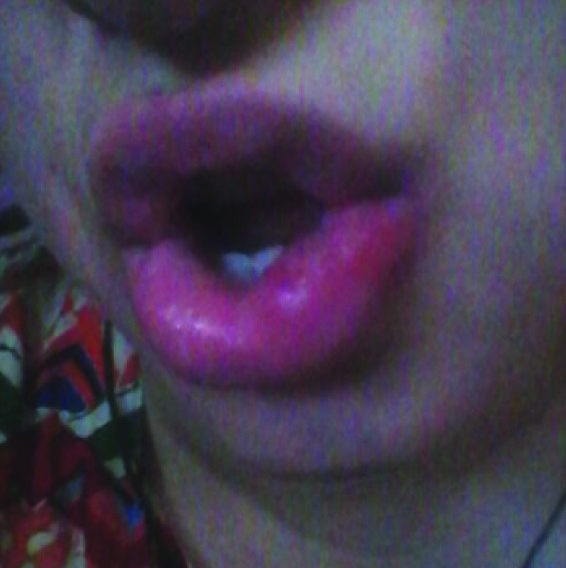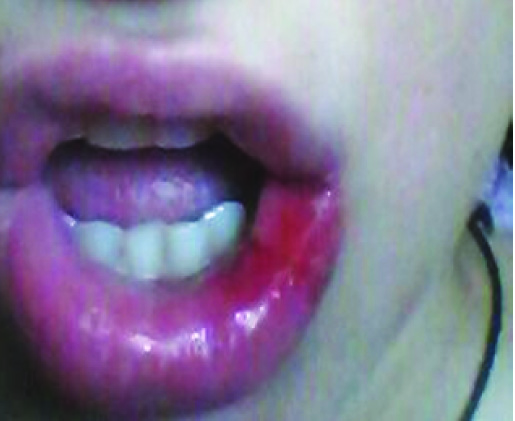Ofloxacin Induced Angioedema: A Rare Adverse Drug Reaction
Gautam Rawal1, Sankalp Yadav2, Raj Kumar3, Umar Rasool Wani4
1 Attending Consultant-Respiratory Intensive Care, Max Super Specialty Hospital, Saket, New Delhi, India.
2 General Duty Medical Officer-II, Department of Medicine & TB, Chest ClinicMoti Nagar, North Delhi Municipal Corporation, New Delhi, India.
3 Senior Consultant and Incharge-Respiratory Intensive Care, Max Super Specialty Hospital, Saket, New Delhi, India.
4 Clinical Associate, Critical Care, Max Super Specialty Hospital, Vaishali, Ghaziabad, Uttar Pradesh, India.
NAME, ADDRESS, E-MAIL ID OF THE CORRESPONDING AUTHOR: Dr Gautam Rawal, Flat No. 417, Dhruva Apartments, Plot no. 4, I P Extension, Patparganj, Delhi-10092, India.
E-mail: drgautamrawal@hotmail.com
The Adverse Drug Reaction (ADR) to a commonly prescribed anti-microbial can pose a major public health problem. The authors report a rare case of 24-year-old young lady who presented with angioedema of lips after ingestion of Ofloxacin, prescribed to her for treatment of loose motions. Fluoroquinolones are widely prescribed antibiotics for various disease conditions. The history, clinical examination and normal laboratory parameters led to the diagnosis of ofloxacin induced hypersensitivity reaction and the patient was successfully treated with corticosteroids and antihistamines. The hypersensitivity reactions to fluoroquinolones are rare with an incidence of 0.4% to 2%. The pharmacovigilance program and self-reporting of all the ADR’s by the health care workers can help in ensuring the judicious use of the drug, drug safety and thus decrease the associated morbidity and mortality.
Case Report
A 24-year-old Indian female arrived in emergency department with complaints of acute swelling of the lower lip [Table/Fig-1] with ulceration [Table/Fig-2], causing pain and discomfort. She gave a history of loose stools and vomiting for two days, for which she was prescribed tablet Ofloxacin 200mg twice daily along with advice to take plenty of oral fluids, by a local general practitioner. The patient took one tablet of Ofloxacin and the frequency of the loose stools gradually decreased, but within few hours of ingestion of the antibiotic, she developed swelling of her lower lip which was increasing in its size along with discomfort and pain. There was no history of breathing difficulty, rashes and itching. Her examination showed normal vitals: pulse rate 74bpm, Blood pressure 120/70mmHg, chest bilaterally clear and normal cardiac rhythms. Her complete haemogram, renal and liver function tests were normal. She didn’t have any known past history of allergic reaction to medicine or food, or history of any allergic condition like dermatitis or asthma. Considering the given history (with no history of any other medicine intake), clinical examination and the normal laboratory findings, an empirical diagnosis of Ofloxacin induced hypersensitivity (angioedema) was made and the patient was advised to stop the offending drug-Ofloxacin. Naranjo’s causality assessment scale graded the reaction as ‘probable’.
Angioedema of the lower lip.

Angioedema of lower lip along with ulceration on the left angle on the mouth.

She was given intravenous Methylprednisolone 40mg stat, Pheniramine maleate (Avil) 25mg intravenous stat and advised tablet Levocetirizine 10mg once daily for five days. After achieving symptomatic relief she was asked to follow-up in outpatient department. The patient showed recovery and the swelling and pain, reduced the next day. A written and informed consent was obtained from the patient for using the clinical images and the details of the case.
Discussion
Ofloxacin is a broad spectrum antibiotic (active against Gram-negative and Gram-positive bacteria) which acts by inhibition of bacterial deoxyribonucleic acid gyrase [1,2]. It belongs to the second generation of the fluoroquinolones group of anti-microbial and can be administered in various forms-oral, injectable and topical. They are one of the commonly used and prescribed antibiotics owing to their broad spectrum antimicrobial coverage (including anti-tubercular action) and also minimal adverse effects [1,2]. In developing countries like India, these medicines are easily available at the drug stores and are one of the most common self-prescribed medicines for acute gastroenteritis, urinary tract infections and respiratory infections [3]. The reaction (angioedema) was analysed using systematic approach with the Naranjo’s causality assessment scale and score was calculated as 6, hence a probable causal relationship was considered [4].
The fluoroquinolones are generally well tolerated by the patients with rare instances of hypersensitivity/anaphylactic reactions. The most common adverse events associated with quinolones are usually mild and do not require hospitalization. These include gastrointestinal tract (nausea, vomiting and diarrhea) in <7% of cases and Central Nervous System (CNS) in <5% cases (headache, dizziness, seizures) and uncommon adverse effects include renal disturbances (crystalluria, interstitial nephritis, acute renal failure), cutaneous hypersensitivity (Steven Johnson Syndrome), photosensitivity, electrocardiogram abnormalities (QT interval prolongation), tendinitis and tendon rupture, impaired glucose metabolism and hepatic toxicity [1,2]. The anaphylactic reaction due to hypersensitivity to fluoroquinolones is of immediate type and IgE mediated and usually occur immediately within one hour of intake [5]. The hypersensitivity reactions to quinolones are rare with an incidence of 0.4% to 2% [1,2,4]. The literature related to hypersensitivity (angioedema) due to Ofloxacin or other quinolones is sparse with few reports of this adverse reaction and also cross reactivity between the various quinolones is clearly demonstrated [1,2,5–12]. Cross-reactivity is due to the molecular ring common to all quinolones [5,6].
An Adverse Drug Reaction (ADR) due to hypersensitivity to any drug has a genetic predisposition and have higher incidence in individuals with a history of atopy, family history of drug allergy and the presence of Human Leukocyte Antigen-B22 (HLA-B22) [12]. The diagnosis of a patient’s allergy to quinolones is based on clinical history, skin prick test, intradermal test and oral challenge. The usefulness of the skin tests is questionable due to the false-negative or false-positive test results and the oral challenge test is more diagnostic [6,13].
In India, admissions due to ADRs roughly accounted for 0.7% of the total number of hospital admissions but unfortunately only 5% of ADRs are reported [10]. The mainstay of the treatment includes avoidance of the offending drug, symptomatic treatment, anti-allergic drugs and anti-inflammatory (corticosteroids) drugs. In case of shock or severe anaphylaxis Adrenaline is the drug of choice [14].
Conclusion
The ADR reporting due to the commonly used drugs in clinical practice is an important step towards the quality assurance of the drug therapy, especially in countries where the availability of counterfeit drugs is a major issue. It should be made mandatory by the law for all the healthcare providers to report any ADR to prevent the drug related morbidity and mortality increasing the patient’s safety. The government authorities should aim for a highly effective pharmacovigilance program. The reported case reminds the clinicians of the life threatening adverse effect of a common and widely prescribed medicine and need for the rational use of antibiotics.
Though hypersensitivity reaction to ofloxacin is rare, proper history should be taken while prescribing this drug. Attention must be paid to potential side-effects of the drugs and close follow-up with patients is a medical necessity to evaluate these adverse reactions, especially in case of quinolones.
[1]. Ramineni HB, Eluri P, Vipparla K, Suryadevara V, Ofloxacin induced hypersensitivity reaction Int J Res Med Sci 2015 3(1):349-51. [Google Scholar]
[2]. Ramani YR, Mishra SK, Rath B, Rath SS, Ofloxacin induced cutaneous reactions in children J Clin Diagn Res 2015 9(6):FD01-FD02. [Google Scholar]
[3]. Yadav S, Rawal G, Self-medication practice in low income countries Int J Pharmceut Chem Anal 2015 2(3):139-42. [Google Scholar]
[4]. Naranjo CA, Busto U, Sellers EM, Sandor P, Ruiz I, Roberts EA, A method for estimating the probability of adverse drug reactions Clin Pharmacol Ther 1981 30:239-45. [Google Scholar]
[5]. Nam Y-H, Kim JE, Kim S-H, Immunologic evaluation of ofloxacin hypersensitivity Allergy, Asthma & Immunology Research 2012 4(6):367-69. [Google Scholar]
[6]. Lobera T, Audícana MT, Alarcón E, Longo N, Navarro B, Muñoz D, Allergy to quinolones: low cross-reactivity to levofloxacin J Investig Allergol Clin Immunol 2010 20(7):607-11. [Google Scholar]
[7]. Jones SC, Budnitz D, Sorbello A, Mehta H, US-Based Emergency Department Visits for fluoroquinolone-associated hypersensitivity reactions Pharmacoepidemiol Drug Saf 2013 22(10):1099-106. [Google Scholar]
[8]. Anjaneyan G, Gupta R, Vora RV, Clinical study of adverse cutaneous drug reactions at a rural based tertiary care centre in Gujarat Natl J Physiol Pharm Pharmacol 2013 3(2):129-36. [Google Scholar]
[9]. Qayoom S, Bisati S, Manzoor S, Sameem F, Khan K, Adverse cutaneous drug reactions – a clinico-demographic study in a tertiary care teaching hospital of the Kashmir Valley, India Arch Iran Med 2015 18(4):228-33. [Google Scholar]
[10]. Marimuthu P, Analysis of adverse drug reaction related hospital admissions and common challenges encountered in ADR reporting in a tertiary care teaching hospital Asian Journal of Pharmaceutical and Clinical Research 2014 7(1):141-43. [Google Scholar]
[11]. Kameswari PD, Selvaraj N, Adhimoolam M, Fixed drug eruptions caused by cross-reactive quinolones J Basic Clin Pharma 2014 5(2):54-55. [Google Scholar]
[12]. Nair PA, Ciprofloxacin induced bullous fixed drug reaction: three case reports J Family Med Prim Care 2015 4(2):269-72. [Google Scholar]
[13]. Blanca-López N, Andreu I, Torres Jaén MJ, Hypersensitivity reactions to quinolones Curr Opin Allergy ClinImmunol 2011 11(4):285-91. [Google Scholar]
[14]. Inomata N, Recent advances in drug-induced angioedema Allergol Int 2012 61(4):545-57. [Google Scholar]